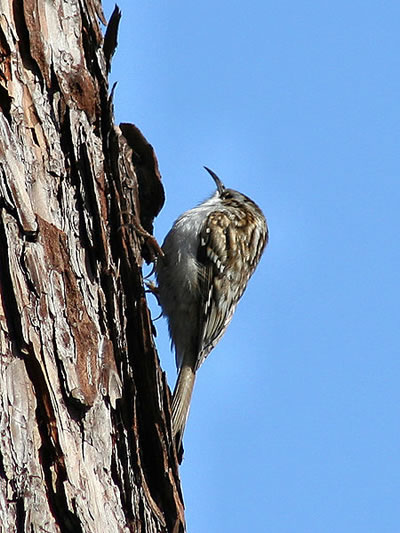Eurasian Treecreeper

Facts about creatures
- Home
- Animal Classification
- Animal Habitats
- Amphibians
- Arthropods
- Bats
- Birds
- Carnivorans
- Cetaceans
- Chordates
- Crustaceans
- Dinosaurs
- Diprotodonts
- Elephants
- Fish
- Golden Mole
- Insects
- Lagomorphs
- Mammals
- Mammal Teeth
- Marsupial Mole
- Metamorphosis
- Mollusks
- Primates
- Reptiles
- Rodents
- Ruminants
- Soricomorphans
- Tenrec
- Tetrapods
- Vertebrates
Eurasian Treecreeper
The Eurasian treecreeper, also known as the common treecreeper is a small tree-climbing, invertebrate-eating passerine bird that can be found in temperate forests throughout Europe and Asia.
It moves in a jerky, yet cautious manner, creeping up tree trunks in small stages. It uses its beak, which curves downward, to catch insects and other invertebrates, such as spiders. It also eats larvae and eggs.

When it reaches as high as it can hunt on one tree, it flies to another tree, where it starts creeping up from the base of the trunk.
Eurasian treecreepers are small and fluffy-looking. They are brown on top and off-white underneath. Males and females have a similar appearance.
They have short wings with pale, crescent-shaped bars.
Their tails are long and brown. As with woodpeckers, the central feathers are particularly strong. Like a woodpecker, the treecreeper uses its tail as a prop, so that it can keep its head up as it moves along tree trunks and tree branches.
The treecreeper is anisodactylous, meaning that it has thee toes in front and one in back. Its long, sharp claws are useful for clinging to bark.
Eurasian treecreepers are most likely to be heard in late winter and early spring.
They have a high-pitched, silvery-toned song, which trills downward and then ends with three clear notes.
Females lay eggs between early April and early June. Most broods contain only one egg. Eggs that are laid late in the season are usually replacements for eggs that were eaten by predators.